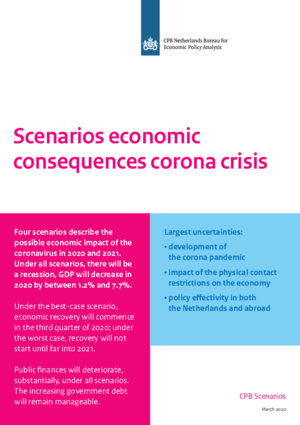Corona crisis scenarios
Corona crisis scenarios: recession unavoidable, increase in government debt bearable

Pieter Hasekamp, CPB Director: ‘Corona, first and foremost, is a health crisis. The measures to contain the spread of the virus are necessary, but these will obviously also have a profound impact on the economy. That said, much is also still uncertain. How long the current measures should remain in force is as yet unknown, nor do we know the exact impact on the economy, as these types of measures have never been implemented before. The longer the restrictions on physical contact remain in place and thus continue to deepen their impact, the greater the likelihood of problems in the financial system and of a deeper recession also in other countries, which in turn will further delay economic recovery.’
| GDP-growth | Unemployment | EMU-balance | ||||
| Scenarios | (%) | (% labour force) | (% GDP) | |||
| 2020 | 2021 | 2020 | 2021 | 2020 | 2021 | |
| I: 3 months of restrictions | -1.2 | 3.5 | 4.0 | 4.5 | -1.3 | -0.5 |
| I: 6 months of restrictions | -5.0 | 3.8 | 4.2 | 5.3 | -4.6 | -2.9 |
| III: 6 months of restrictions, more negative impact | -7.7 | 2.0 | 6.3 | 8.4 | -6.8 | -5.7 |
| IV: 12 months of restrictions, additional problems from abroad and in the financial sector | -7.3 | -2.7 | 6.1 | 9.4 | -7.3 | -9.9 |
In 2021, in our mildest scenario, unemployment will increase only slightly, but in our gravest scenario, it is projected to increase to 9.4%. Hasekamp: ‘Government policy is aimed at limiting lay-offs and bankruptcies. This is projected to prevent both a downward spiral and permanent economic damage. Nevertheless, such government support will only be able to partially soften the blow. The longer the crisis lasts, the greater the economic damage will be.’
The emergency measures to support the economy will cause a sharp deterioration in public finances, under all scenarios. There will not be a direct risk to the level of government debt, as, even under the worst-case scenario, by the end of 2021, the debt will be 73.6% of GDP, which is still far removed from levels identified as risky in the literature.
Questions and answers
Why is CPB publishing these scenarios at this point in time?
The economic outlook has changed, dramatically, within a short period of time. When we published our most recent projections, the coronavirus was still mainly an issue only in China. At that time (publication date 3 March), only a handful of cases had been detected in the Netherlands and there was still hope that these could be isolated. However, because it was already clear that the implications of the coronavirus could be very large, we did highlight the level of uncertainty and included a variant with limited further spread of the virus. Today, we are facing a different economic reality. The measures restricting physical contact and the uncertainty that is created by the crisis are having a visible impact on economic activity. There are still many uncertainties, and macroeconomic data are as yet hardly available. In such a situation, projections are not very meaningful. This is why we use scenarios to show the order of magnitude of the impact, and provide an indication of the main uncertainties.
Why were these particular scenarios chosen?
These scenarios were chosen to illustrate some of the main uncertainties and give an impression of possible economic consequences. There are also other conceivable scenarios. We chose certain assumptions in an attempt to present a somewhat plausible variation, but other assumptions are also possible. The scenarios, therefore, should not be regarded as a lower or upper limit of possible outcomes.
Which scenario is the most likely?
CPB makes no statement about which scenario would be the most likely. The value of scenario analysis is not so much about the precise outcomes of a given scenario, but rather about comparing scenarios against each other. This gives an impression of the order of magnitude of economic effects and reveals the main uncertainties. However, as more information becomes available, the degree of probability will become clearer for each of the scenarios.
Will CPB publish regular updates of these scenarios?
We currently have no plans to do so. However, if the economic picture changes drastically compared to what we know today, then of course we will revisit this decision. In June, CPB will publish its regular new projections.
Contacts

Downloads
Questions and answers
Why is CPB publishing these scenarios at this point in time?
The economic outlook has changed, dramatically, within a short period of time. When we published our most recent projections, the coronavirus was still mainly an issue only in China. At that time (publication date 3 March), only a handful of cases had been detected in the Netherlands and there was still hope that these could be isolated. However, because it was already clear that the implications of the coronavirus could be very large, we did highlight the level of uncertainty and included a variant with limited further spread of the virus. Today, we are facing a different economic reality. The measures restricting physical contact and the uncertainty that is created by the crisis are having a visible impact on economic activity. There are still many uncertainties, and macroeconomic data are as yet hardly available. In such a situation, projections are not very meaningful. This is why we use scenarios to show the order of magnitude of the impact, and provide an indication of the main uncertainties.
Why were these particular scenarios chosen?
These scenarios were chosen to illustrate some of the main uncertainties and give an impression of possible economic consequences. There are also other conceivable scenarios. We chose certain assumptions in an attempt to present a somewhat plausible variation, but other assumptions are also possible. The scenarios, therefore, should not be regarded as a lower or upper limit of possible outcomes.
Which scenario is the most likely?
CPB makes no statement about which scenario would be the most likely. The value of scenario analysis is not so much about the precise outcomes of a given scenario, but rather about comparing scenarios against each other. This gives an impression of the order of magnitude of economic effects and reveals the main uncertainties. However, as more information becomes available, the degree of probability will become clearer for each of the scenarios.
Will CPB publish regular updates of these scenarios?
We currently have no plans to do so. However, if the economic picture changes drastically compared to what we know today, then of course we will revisit this decision. In June, CPB will publish its regular new projections.
Contacts

